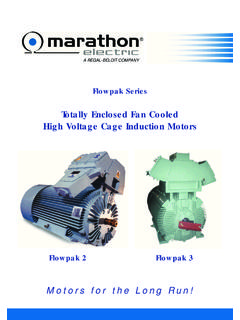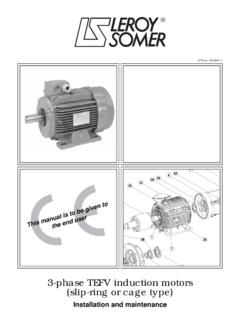Transcription of Reversing starter circuit for single phase induction …
1 Reversing starter circuit for single phase induction motors Updated 1st September 2008 Most single phase electric motors fitted to machine tools, compressors etc. are squirrel cage induction type which can be reversed by re-arranging connections to their terminals. Drum or rotary switches are often used to select direction of rotation of single phase motors but they are expensive, do not have a No Volt Release (NVR), nor overload protection and are not ideal for switching motors on or off. Basic circuit - figure 1 There are Stop, Forward and Reverse buttons, two low current double pole double throw relays for the control circuit (thin wire lines) and the power circuit (thick wire lines) which uses a double pole single throw relay (RMAIN) and a double pole double throw relay (RDIR).
2 The circuit is drawn with the control circuit isolated from the power section; that enables the use of relays with coils that operate at a different voltage from the mains. Where that is done, the relay coils must all operate at the same voltage and power for them is applied to A and B. Where the relay coils operate at mains voltage simply link L to A and N to B. When RMAIN is energised and RDIR is unenergised the motor runs in one direction but, if RDIR is energised, the motor runs in the reverse direction. The contacts 6 to 7 of RF and RR act as NVR (No volt release) latches for the Fwd & Rev buttons and 6 to 7 of RR energise the coil of RDIR when the Rev button is pressed or latched.
3 Contacts 3 to 5 remove power to the Rev button when the motor is running forward and vice versa; this ensures that pressing either, or both, direction buttons, when the motor is running, has no effect. Contacts 3 to 4 of either energise the coil of RMAIN when a direction button is pressed or latched. A remote stop button may be wired in place of LK1. Note that there is no protection for motor overload other than any fuse or circuit breaker in the mains supply. Enhanced circuit - figure 2 RMAIN of fig. 1 is replaced by a conventional motor contactor (CO1) and overload device (OL1).
4 The N/C contact of OL1 is in series with the stop circuit so the motor stops when an overload occurs. Practical considerations Pin numbering The pin numbers in the figures are arbitrary and only drawn to assist in describing or tracing the function of the circuit . motor types There are several varieties of single phase squirrel cage motors which are well described at 10 Oct 2010. The above link is no longer valid I have emailed Leeson to see if the page is available elsewhere motor connections Most motors have a terminal box bolted to, or comprising part of, the main body.
5 Wires from the windings or rotary switch (within the motor body) pass straight into the terminal box. Apart from split- phase motors, one or two capacitors are normally fixed to the outside of the body and their leads pass into the box via individual gland or grommet holes. A further gland or grommet hole is provided for the cable supplying power. You need to determine which terminals are connected to the main and start/aux windings of the motor . Quite often there will be a label inside the terminal box showing which are which.
6 They are also, sometimes, labelled but there is no standardised marking. Some quite common ones are: Start terminals Z and T Run terminals A and AZ or Start terminals Z1 and Z2 Run terminals U1 and U2 or Start terminals Z1 and Z2 Run terminals A1 and A2 Where no such identification is available, the terminals can be identified by measuring the resistance between pairs of terminals. The resistance of the start/aux winding is always greater than that of the main winding by, typically, a factor of 2 or 3.
7 As an example, a 500W motor s start winding is 36 ohms and the main is 16. Values will be a lot lower for larger motors. Note that the reading between terminals 5 & 6 of the Cap start/Cap run circuit will be 0 ohms so should not be confused with the low resistance of the main winding. Typical connection circuits for different motor types are given below but they may not apply to all configurations. For example, the connection between the rotary switch and start/aux switch may be done at an additional terminal instead of inside the motor body.
8 IF IN DOUBT, ASK SOMEONE WHO KNOWS ABOUT MOTORS 123456 CSTARTCRUNSTARTRUNTERMINAL BOXMOTORCAP START/CAP RUN12345 CSTARTSTARTRUNTERMINAL BOXMOTORCAP START/ induction BOXMOTORPERMANENT SPLIT BOXMOTORSPLIT-PHASEMAINSTART Relays and contactor If the basic circuit is used then the contact rating (for inductive loads) of Rmain should be at least that of the starting current of the motor which may be several hundred percent of the full load current. Some figures are given in the link listed in motor types . In practice you can probably get away with a lower rating for hobby use but it should be rated for at least the full load current.
9 A contactor intended for motor control only needs to be rated for the full load current of the motor as it is designed to handle larger make and break currents. The overload should be set to the full load current. Note that overloads are normally mounted directly to the contactor so do not try to mix devices from different manufacturers or ranges without checking that they mount satisfactorily. The contactor/overload is wired so that the line current passes through 2 poles. This is because they are normally made in three pole version for three phase installations and some may trip if there is an imbalance of current through the overload poles as would occur if one phase of a three phase motor failed or became disconnected.
10 For both the basic and enhanced circuits the contact rating of Rdir need only be the motor full load current of the motor and could, quite possibly, be less. For most configurations a contact rating of 500mA for RF & RR is adequate but if the coil voltage of relays is low or the enhanced circuit is used then a higher rating may be required check the current required to energise the coils. Bob Kellock August 2008 Update 1st September 2008 This is a variation which uses a 3 way Fwd-Off-Rev switch and Start button instead of 3 three buttons.




